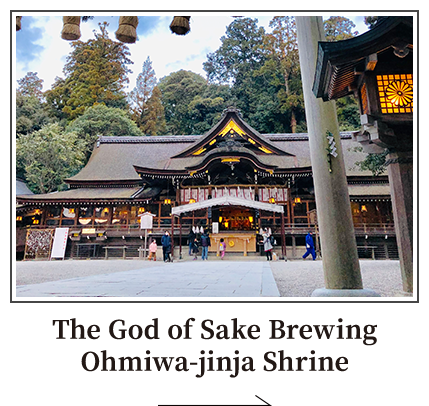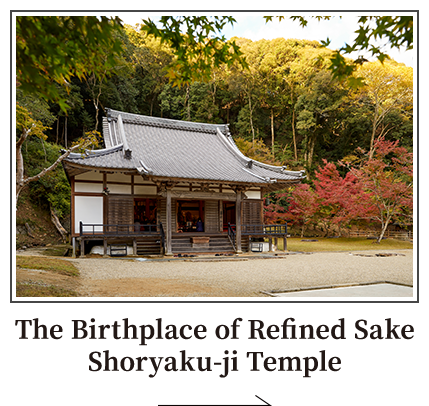 Nara and Sake
Nara and Sake
The God of Sake Brewing Ohmiwa-jinja Shrine
Situated at the base of Mount Miwa, Ohmiwa-jinja Shrine in Sakurai City is Japan’s oldest shrine. The mountain itself is a deity, known as “Mimuro-yama.” In Japanese, the kanji characters for mimuro mean “sake’s origins” and, since ancient times, the mountain has been worshipped as a god of sake. This name even makes an appearance in the Nihon Shoki, Japan’s oldest official history. One day, as an epidemic plagued Japan, Emperor Sujin is said to have had a dream in which he received a divine message from the deity Omononushi-no-Okami, commanding him to appoint a man named Otataneko as the priest of the Ohmiwa-jinja Shrine and to make an offering of sake.
Emperor Sujin immediately called upon the brewer Takahashi Ikuhi no Mikoto, and, in just one night, had the sake brewed to make his offering. This is said to have brought an immediate end to the plague.
This is how Takahashi came to be enshrined at Ohmiwa-jinja Shrine’s auxiliary Ikuhi-jinja Shrine. Looking at ancient maps, this shrine was known as Hitoyozake no Yashiro, meaning “shrine of overnight sake,” and locals refer to it as “Hitoyozake-san” even today. A sake brewery was located nearby until the beginning of the Meiji period (1868–1912) that appears to have also housed sake brewing equipment.
The name Miwa, whose characters in Japanese mean “three rings,” is deeply connected to both sake and Shinto rituals. Take sake given as an offering to the gods, for example. It is said that when drunk on sake, it is easier for your spirit to be in harmony with the gods, and as such sake has been considered important for connecting to higher powers since ancient times. Today, sake offered to the gods is called omiki, among other names, yet in the past its characters were read as miwa. Even the characters for the gods themselves were read as miwa and although the characters for Ohmiwa-jinja do not usually read as “Ohmiwa,” it is also for this reason that the name of the shrine is called the way it is today. By looking at the ancient Japanese, one can understand the relationship between sake, the gods, and the name Miwa.
-

Ikuhi-jinja Shrine 
Sugidama, the large spheres made of Japanese cedar traditionally hung outside sake breweries each year to announce the production of a new batch, are sent from Ohmiwa-jinja Shrine to breweries all over Japan. In each region, a wooden tag reading “miwa myojin, shirushi no sugidama” is hung from these sugidama, signifying that they come from Mount Miwa, the sacred mountain that enshrines the god of sake.
Sake production begins between autumn and winter. In February or March, pure sake is taken from the original brew and fermented, and the sake produced by the last day of June each year is called shinshu, or “new sake.” It is around this time that the vivid green sugidama are displayed. Over the course of the next year, the sugidama gradually wither and turn from green to brown. And so, bright green sugidama signify freshly brewed sake. As the green fades, one can expect delicious natsuzake in the summertime, and the brown color of the sugidama at the beginning of autumn signifies the availability of seasonal hiyaoroshi sake.
Every year on November 14th, sake brewers from all over the country gather at Ohmiwa-jinja Shrine for a sake festival called Jozo Anzen Kigan-sai. At this festival, the brewers pray for the safe production of their new sake. First, the head priest recites an invocation to the gods of sake brewing, which is then followed by the performance of a ritual dance called Umazake Miwa no Mai. The brewers then make a prayer to Ikuhi-jinja Shrine that they may produce delicious new sake. Sake is distributed within the shrine’s grounds, creating a lively atmosphere among not only the brewers, but also other shrine visitors. After the ceremony, Shinto staffs decorated with sacred red paper and sugidama are given to the brewers for the safe production of their sake, and the enormous sugidama that adorn two of the main halls of Ohmiwa-jinja Shrine, both of which are about 1.5 meters in diameter and weigh around 200 kilograms, are replaced with fresh, bright new ones.


